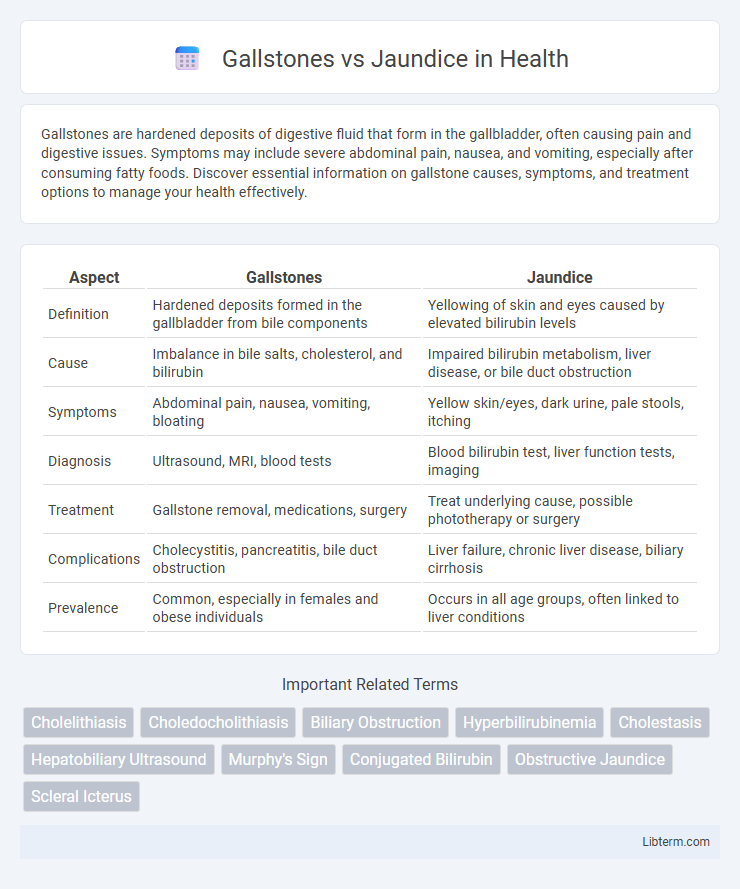Gallstones are hardened deposits of digestive fluid that form in the gallbladder, often causing pain and digestive issues. Symptoms may include severe abdominal pain, nausea, and vomiting, especially after consuming fatty foods. Discover essential information on gallstone causes, symptoms, and treatment options to manage your health effectively.
Table of Comparison
| Aspect | Gallstones | Jaundice |
|---|---|---|
| Definition | Hardened deposits formed in the gallbladder from bile components | Yellowing of skin and eyes caused by elevated bilirubin levels |
| Cause | Imbalance in bile salts, cholesterol, and bilirubin | Impaired bilirubin metabolism, liver disease, or bile duct obstruction |
| Symptoms | Abdominal pain, nausea, vomiting, bloating | Yellow skin/eyes, dark urine, pale stools, itching |
| Diagnosis | Ultrasound, MRI, blood tests | Blood bilirubin test, liver function tests, imaging |
| Treatment | Gallstone removal, medications, surgery | Treat underlying cause, possible phototherapy or surgery |
| Complications | Cholecystitis, pancreatitis, bile duct obstruction | Liver failure, chronic liver disease, biliary cirrhosis |
| Prevalence | Common, especially in females and obese individuals | Occurs in all age groups, often linked to liver conditions |
Understanding Gallstones: Causes and Symptoms
Gallstones form when bile components such as cholesterol or bilirubin harden into solid particles within the gallbladder, often due to imbalances in bile composition, obesity, or rapid weight loss. Typical symptoms include intense pain in the upper right abdomen, nausea, and vomiting, especially after fatty meals. Differentiating gallstone pain from jaundice involves noting that jaundice primarily causes yellowing of the skin and eyes due to bile duct obstruction or liver dysfunction, whereas gallstones cause localized gallbladder inflammation and biliary colic.
What is Jaundice? Overview and Key Indicators
Jaundice is a medical condition characterized by yellowing of the skin and eyes due to elevated bilirubin levels in the bloodstream, often signaling liver dysfunction. Key indicators include dark urine, pale stools, itching, and fatigue, which help differentiate jaundice from gallstones, typically marked by severe abdominal pain and digestive issues. Understanding bilirubin metabolism disruptions is essential for diagnosing underlying causes such as liver disease, bile duct obstruction, or hemolysis.
Gallstones vs Jaundice: Core Differences
Gallstones are hardened deposits of digestive fluid that form in the gallbladder, causing pain, nausea, and potential blockage of bile flow. Jaundice is a yellowing of the skin and eyes resulting from elevated bilirubin levels due to liver dysfunction, bile duct obstruction, or hemolysis. The core difference lies in gallstones being a physical obstruction primarily affecting bile secretion, while jaundice is a clinical symptom indicating underlying hepatic or biliary pathology.
How Gallstones Lead to Jaundice
Gallstones can block the bile ducts, preventing bile from flowing from the liver to the intestines, which causes bile to build up in the liver and bloodstream, leading to jaundice. This obstruction increases bilirubin levels in the blood, resulting in yellowing of the skin and eyes. Gallstones in the common bile duct, known as choledocholithiasis, are a primary cause of obstructive jaundice.
Risk Factors for Developing Gallstones and Jaundice
Risk factors for developing gallstones include obesity, female gender, age over 40, pregnancy, rapid weight loss, and a diet high in cholesterol or low in fiber. Jaundice risk factors involve liver diseases such as hepatitis, bile duct obstruction, hemolytic anemia, and genetic disorders affecting bilirubin metabolism. Both conditions share some common factors like bile duct obstruction, but gallstones primarily result from imbalances in bile composition, whereas jaundice arises from impaired bilirubin processing or excretion.
Diagnostic Approaches for Gallstones and Jaundice
Ultrasound imaging is the primary diagnostic tool for detecting gallstones, offering high sensitivity in identifying stones within the gallbladder and bile ducts. Blood tests measuring bilirubin levels, liver enzymes (ALT, AST, ALP), and complete blood count help distinguish jaundice causes, indicating liver function impairment or bile duct obstruction. In complex cases, magnetic resonance cholangiopancreatography (MRCP) and endoscopic retrograde cholangiopancreatography (ERCP) provide detailed visualization of bile ducts for both gallstone detection and jaundice diagnosis.
Treatment Options: Gallstones vs Jaundice
Treatment options for gallstones primarily include surgical removal through cholecystectomy or non-invasive procedures like extracorporeal shock wave lithotripsy (ESWL) to break down stones. Jaundice treatment is focused on addressing the underlying cause, such as bile duct obstruction, liver disease, or hemolysis; options may involve medication, surgery, or biliary drainage. Both conditions require accurate diagnosis to guide appropriate intervention, with gallstone removal relieving bile flow obstruction and specific therapies targeting liver function restoration in jaundice cases.
Complications Arising from Gallstones and Jaundice
Gallstones can lead to complications such as cholecystitis, pancreatitis, and bile duct obstruction, which may result in severe abdominal pain and infections. Jaundice, often caused by gallstones blocking the bile ducts, manifests as yellowing of the skin and eyes due to elevated bilirubin levels and can indicate liver dysfunction or bile flow obstruction. Both conditions require prompt medical attention to prevent further complications like sepsis or chronic liver disease.
Prevention Strategies for Both Conditions
Maintaining a healthy diet rich in fiber and low in saturated fats helps prevent gallstones by reducing cholesterol buildup in bile. Regular exercise and adequate hydration support liver function, decreasing the risk of jaundice caused by liver dysfunction or bile duct obstruction. Avoiding excessive alcohol consumption and managing underlying health conditions like obesity and diabetes are critical prevention strategies for both gallstones and jaundice.
Frequently Asked Questions: Gallstones and Jaundice
Gallstones often cause pain, nausea, and digestive issues by blocking bile flow, while jaundice is characterized by yellowing of the skin and eyes due to excess bilirubin in the blood. Gallstones can lead to jaundice if they obstruct the bile ducts, preventing proper bile drainage. Treatment for gallstones may involve dietary changes, medication, or surgery, whereas jaundice treatment focuses on addressing the underlying cause, such as liver disease or bile duct obstruction.
Gallstones Infographic

 libterm.com
libterm.com